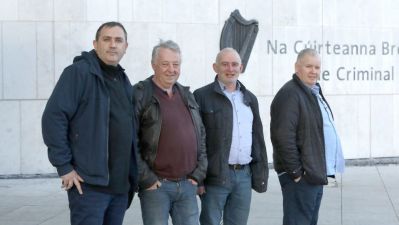A former All-Ireland winner who stole an "eye-watering" sum of money as part of a cross-border gang that used stolen diggers to pull ATMs from walls has failed in a bid to overturn his conviction after challenging the identification of him at the scene of a foiled raid.
In sentencing Daniel O'Callaghan to ten years' imprisonment last March, Ms Justice Tara Burns said the accused took part in an "audacious" operation on behalf of a "well-oiled" criminal organisation that committed a series of ATM thefts and an attempted theft that was thwarted by gardaí in 2019.
O'Callaghan (33), formerly of Monog Road, Crossmaglen, Co Armagh, who won three All-Ireland club medals playing for Crossmaglen Rangers, was convicted at the Special Criminal Court after a trial for 16 offences relating to a series of ATM thefts in Meath, Cavan and Monaghan carried out by the gang in 2018 and 2019.
Identification
At the Court of Appeal on Tuesday, Vincent Heneghan SC, for O'Callaghan, argued that the identification of his client had been flawed and that an application at trial for O'Callaghan's acquittal had been incorrectly refused.
Mr Heneghan said the trial judges had made a "significant finding of fact" when accepting the evidence of the National Surveillance Unit (NSU) garda in Virginia on the night of the botched ATM theft.
Mr Heneghan said that O'Callaghan was appealing his convictions because of the "pivotal and fundamental" identification claim made by the NSU officer, which was an identification more relied upon by the sentencing court than a separate one made by the ERU garda.
Mr Justice George Birmingham, presiding at the Court of Appeal, said the question for the court was whether or not the identification by the NSU garda was right or wrong and that there was "an abundance of other evidence to say he was dead right".
Mr Heneghan said the NSU garda gave evidence to say he had a view of two men fleeing a Toyota Landcruiser, running towards his position, when it was rammed by gardaí. The garda said he identified O'Callaghan and had around 30-40 seconds to do so, said Mr Heneghan.
Mr Heneghan said, however, if the position of the garda was consistent with what he told the trial, then he was 12-15 metres from the incident and could not have had this amount of time to make the identification. Counsel said it would have taken as little as three seconds for O'Callaghan to exit the Landcruiser and make up the ground if he was sprinting by the NSU garda.
Counsel added that the NSU garda said he was aware of O'Callaghan from garda intelligence, social media posts and photos but had not physically identified O'Callaghan before.
Trained observer
Ms Justice Isobel Kennedy said the NSU garda was a trained observer with other surveillance skills learned over years and that he had been involved in the investigation for months.
Mr Justice Birmingham said the garda "didn't turn up by chance on the night" of the attempted theft and that the identification of O'Callaghan had been borne out by DNA evidence.
Mr Heneghan said that at the trial the NSU garda had given a location on a map to mark his position but had changed it and then given another. Counsel said the garda then gave a third location as to his position on the street by marking a photograph of the scene.
Mr Justice McCarthy said the NSU garda had been "virtually opposite" the ATM on the night and therefore had "a pretty good opportunity to identify" O'Callaghan.
Mr Heneghan said it was dark, there had been rain on the night and that another male, fleeing the digger, had also been identified in the seconds available to the NSU observer.
'Overwhelming evidence'
Mr Birmingham said the "overwhelming evidence in the case shows he [the NSU garda] got it one hundred per-cent right", adding that it was "almost impossible to have a stronger case - it's as strong as it is possible to imagine".
In dismissing the appeal, Mr Justice Birmingham said the NSU garda had been given a map he had never seen before and quickly amended where he marked it at the trial.
Mr Justice Birmingham said the NSU garda had been working on the investigation for two-to-three months and had a clear view of the ATM on the night when two of the gang ran past him. The judge said the NSU garda had been a "truthful, reliable, honest witness and there's no basis for any suggestion of any evidence being fabricated".
Mr Justice Birmingham said there had been no "significant divergence" between the two locations marked on the map and that the court did "not believe it to be fair and accurate" to say that a third location was then identified on a photo.
The judge said that whether or not the NSU garda had three seconds or 40 seconds it did not call into question the prowess of the identification of O'Callaghan.
Mr Justice Birmingham said the opportunity to identify O'Callaghan was good, made from the ground level as he passed at close proximity and that the NSU garda had taken time to familiarise himself with the appellant.
Mr Justice Birmingham said the Special Criminal Court was "fully entitled to convict" O'Callaghan for the Virginia ATM attempted theft, which was a "gateway" to the other convictions. He then dismissed the appeal.
'Eye-watering' sum of money
At the sentencing hearing, Ms Justice Burns said O'Callaghan had control over what the judge said was an "eye-watering" sum of stolen money, amounting to more than €700,000.
O'Callaghan played a central role, the judge said, as a planner and active member of the gang. She said O'Callaghan contested the charges against him despite being caught "red-handed" at the scene of an attempted ATM theft in Virginia, Co Cavan.
Four of O'Callaghan's accomplices were also jailed for their roles in the ATM thefts.
The gang's final attempt to steal an ATM was thwarted by gardai who were watching as they drove a digger up to an ATM on the main street of Virginia Co Cavan in the early hours on August 14th, 2019.
Gardaí saw a stolen Toyota Landcruiser move in convoy with the digger. The Landcruiser was pulling a trailer into which the gang intended to place the ATM before taking it to a premises at Tullypole, Moynalty, Co Meath, where the money would be removed.
Gardai rammed the Landcruiser, prompting O'Callaghan and another man to run from the jeep while a third man ran from the digger.
All three jumped over a wall into a field but before they got away a garda from the and another garda from the Emergency Response Unit (ERU) identified O'Callaghan.

Ms Justice Burns said the court accepted the identification evidence of the two gardaí.
She said the identification by the NSU officer was particularly reliable because he had familiarised himself with O'Callaghan over many years as part of his duties in preventing and detecting cross-border crime. The officer was just a few feet away from O'Callaghan with a clear view when he made the identification, Ms Justice Burns said.
O'Callaghan's DNA was also found in a sauna in a nearby shed where O'Callaghan hid while gardai searched the area and caught two of his accomplices.
The owner of the shed told gardai he suspected an intruder had interfered with the insulation in the shed's attic. Ms Justice Burns said the DNA evidence provided support for the identification evidence of the two gardaí.







